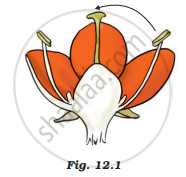Advertisements
Advertisements
प्रश्न
Why does self-pollination not lead to seed formation in self-incompatible species?
उत्तर
Self-incompatibility is a gene-physiological event. A single gene, known as the S-gene, regulates incompatibility reactions and contains many alleles. Pollen grains that have the S-allele, which is shared by any of the two alleles found in pistil cells, will not function on that pistil. However, any pollen grain that does not share any S alleles with the pistil of that plant will be functional on the pistil. Self pollens are unable to fertilise the egg, resulting in the formation of an embryo, hence seeds do not form in incompatible species.
APPEARS IN
संबंधित प्रश्न
A flower of tomato plant following the process of sexual reproduction produces 240 viable seeds.
Answer the following questions giving reasons :
(a) What is the minimum number of pollen grains that must have been involved in the pollination of its pistil?
(b) What would have been the minimum number of ovules present in the ovary?
(c) How many megaspore mother cells were involved?
(d) What is the minimum number of microspore mother cells involved in the above case?
(e) How many male gametes were involved in this case?
Can cross-pollination occur in cleistogamous flowers? Give reason for your answer.
What is bagging technique?
Give the floral adaptations for anemophily.
What is meant by pollination?
Fill in the blanks with suitable words.
_______ is a water-pollinated flower.
Mention any two contrivances in flowers which favour cross-pollination.
Describe the advantages and disadvantages of cross-pollination to the plant.
In bisexual flowers, maturation of gynoecium before androecium is known as ______.
Differentiate between geitonogamy and xenogamy.
Answer the following question.
Write the difference in the characteristics of the progeny produced as a result of the two processes.
Answer the following question.
Can a plant flowering in Mumbai be pollinated by pollen grains of the same species growing in New Delhi? Provide explanations to your answer.
Write different modes of pollination in detail with suitable examples.
Differentiate Between Cross Pollination and Self Pollination:
What are the adaptations which are required in self-pollinated plants?
What are the different adaptations shown by bird-pollinated flowers?
Which of the following plant contain unisexual flower?
Pollination refers to the
Which type of pollination does Figure 12.1 indicate?

What are the major abiotic factors that influence habitat?
